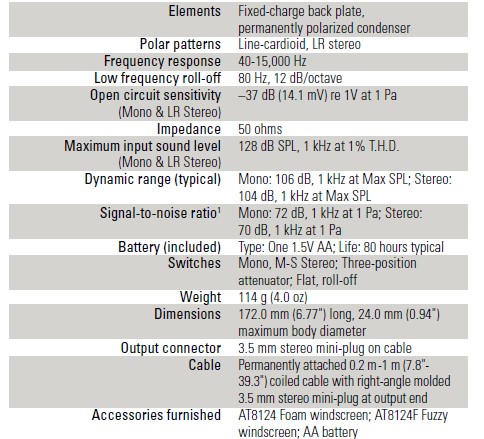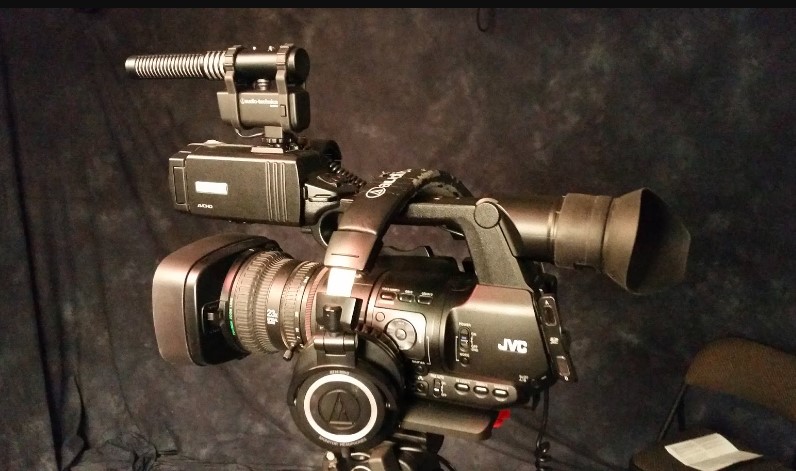
Audio-Technica AT8024 Stereo-Mono Condenser Microphone
About Audio Technica
Audio-Technica is a well-known Japanese audio equipment manufacturer that specializes in the design and production of high-quality audio products. The company was founded in 1962 by Hideo Matsushita and is headquartered in Tokyo, Japan. Since its inception, Audio-Technica has gained a strong reputation in the audio industry for its commitment to innovation, craftsmanship, and technical expertise.
The company’s product range includes a wide variety of audio equipment, such as headphones, microphones, turntables, wireless systems, and other audio accessories. They cater to various markets, including professional audio, broadcast, live sound, studio recording, and consumer audio.
Features
- Designed for use with DSLR and other video cameras, it delivers dramatically better sound quality than the camera’s internal microphone
- Selectable line-cardioid mono or mid-side stereo modes provide the flexibility to capture high-resolution audio in any environment
- Three-position adjustable attenuator and switchable low-frequency roll-off
- Integral rubber shock mounts isolate the microphone from vibration and mechanical camera noise
- Compact, lightweight design with integral shoe mount
Description
The AT8024 is a fixed-charge condenser microphone designed for use with DSLR and other video cameras. The microphone offers the flexibility of mono and mid-side stereo modes for high-resolution audio in any environment.
The microphone is powered by a single 1.5V AA battery, included. The AA battery provides optimal performance with high max SPL. A red/green LED power indicator, located on the top of the unit, illuminates green when the microphone is sufficiently powered and red when battery power is low. The AT8024 is equipped with a three-position attenuator switch. The microphone also features an 80 Hz high-pass filter switch that permits the choice of flat response or low-frequency roll-off to reduce the pickup of undesired ambient noise, room reverberation, and mechanically coupled vibrations.
The microphone is enclosed in a rugged housing and includes an integral shoe mount that fits most camera shoes. Two rubber shock mounts isolate the microphone from vibration and mechanical camera noise.
The microphone includes a permanently attached cable with a 3.5 mm (1/8″) L-type stereo plug output. A clip on the shoe mount holds the cable, relieving tension and preventing vibration noise. A foam windscreen and fuzzy windscreen are also included.
Operation & Maintenance
The mode switch located on the top of the unit allows the user to select between mono and internally matrixed mid-side stereo modes.
Mono Operation: In Mono mode, the microphone uses its line-cardioid element exclusively to provide excellent off-axis rejection. This is ideal for recording interviews, dialogues or sound sources that might otherwise be drowned out in noisy environments.
Mid-Side Stereo Operation: In Stereo mode, the microphone provides internally matrixed mid-side stereo, delivering wide, life-like stereo sound. Locating the AT8024 nearer the sound source will enhance the apparent width of the stereo image while decreasing room ambiance. Moving the microphone away from the sound source will narrow the stereo image and provide more “room sound.” The Stereo mode is well-suited for sporting events and other active situations where sonic realism is desired.
The integral shoe mount slides into the shoe of most cameras. Tighten the nut on the shoe mount to hold the microphone securely in place. The shoe mount is also equipped with a strain-relief clip for the cable. Insert the cable into the clip to reduce wear on the cable and eliminate noise from cable vibration.
To install the battery, press the PUSH button located on the side of the unit. This will eject the battery compartment. Insert a 1.5V AA battery according to the polarity markings in the compartment, then press the compartment back into the body of the unit so that it clicks closed. When the mode switch is moved from the Off position to Mono or Stereo, the LED power indicator will illuminate green, showing that the microphone has power. Replace or recharge the battery when the LED illuminates red.
The output level can be adjusted by using the three-position attenuator switch (-20 dB, -10 dB, 0 dB) located on the top of the unit. Adjust according to the volume of the sound source: -20 dB for the loudest sounds, 0 dB for the softest. The 80 Hz high-pass filter switch is located alongside the attenuator switch. To engage the high-pass filter, slide the switch toward the “bent” line.
Since even slight or unexpected winds can adversely affect audio recordings, it is best to use the microphone with the supplied windscreen or, when recording in especially windy environments, the supplied fuzzy windscreen.
Avoid leaving the microphone in the open sun or in areas where temperatures exceed 110° F (43° C) for extended periods. Extremely high humidity should also be avoided.
To reduce the environmental impact of a multi-language printed document, product information is available online at www.audio-technica.com in a selection of languages.
Specifications

In the interest of standards development, A.T.U.S. offers full details on its test methods to other industry professionals on request.
1 Pascal = 10 dynes/cm2 = 10 microbars = 94 dB SPL
1 Typical, A-weighted, using Audio Precision System One. Specifications are subject to change without notice.
frequency response: 40–15,000 Hz

polar patterns

FAQs About Audio-Technica AT8024 Stereo-Mono Condenser Microphone
How is a stereo microphone used?
It is a recording tool with two internal microphones. They can now record sounds in the same way that human ears do because of this. Stereo microphones create stereo outputs that give the recording depth and direction as they simultaneously record sounds with two microphones.
Do condenser microphones capture stereo audio?
An incredibly lifelike stereo image can be created by patterning a pair of tiny diaphragm condensers. In actuality, a small diaphragm condenser microphone is the one you’ll most frequently find on a portable field recorder.
How are condenser microphones used?
Condenser microphones are most frequently employed in the studio, where their improved frequency and transient response, as well as their reduced self-noise, make them ideal for capturing clear, high-fidelity recordings that accurately represent the sound source.
Which is preferable, mono or stereo?
Stereo audio and mono records have different sounds, not better or worse. You’ll note that stereo recordings have a broader sense of space and a more current feel than mono recordings, which tend to have a more concentrated, punchier sound.
What makes stereo superior to mono?
Because stereo audio isn’t constrained to a single audio channel, it often sounds broader and more dynamic. Using several channels gives all the various components and layers on a track more room to shine. And as a result, the sound is more realistic, detailed, and 3D-like.
What advantages can stereo microphones offer?
With the ability to pan sounds to the left and right, stereo provides a new sound staging. The individual musicians will therefore be positioned where they were on stage in your recording if you utilize a stereo microphone to record a band, delivering acoustic enjoyment.
Which microphone techniques are there?
The majority of vocalist microphones have an area where they can detect noise. It’s critical to strike this radius with each note you sing in order to have great mic technique.
Does stereo require two microphones?
Instruments are typically miked in mono, that is, with a single microphone, for multitrack recording projects. However, in some circumstances, using two mics to record the sound in stereo will produce better-sounding results.
What is a condenser microphone’s optimum quality?
They are ideal for crystal-clear, in-depth recordings of delicate sounds like acoustic instruments or live voice performances.
Do condenser microphones lessen noise?
It is more sensitive to use a condenser microphone. In comparison to a dynamic microphone, it turns noise into electrical at a higher level. It is more sensitive to every noise, including the sound of your voice and the air conditioner.
How are stereo recordings made?
Stereophonic sound, or just stereo as it is commonly known, refers to any recording or sound transmission method that makes use of multiple microphones and loudspeakers.
For More Post Visit: Manuals Dock
[embeddoc url=”https://manualsdock.com/wp-content/uploads/2023/08/Audio-Technica-AT8024-Stereo-Mono-Condenser-Microphone.pdf” download=”all”]


